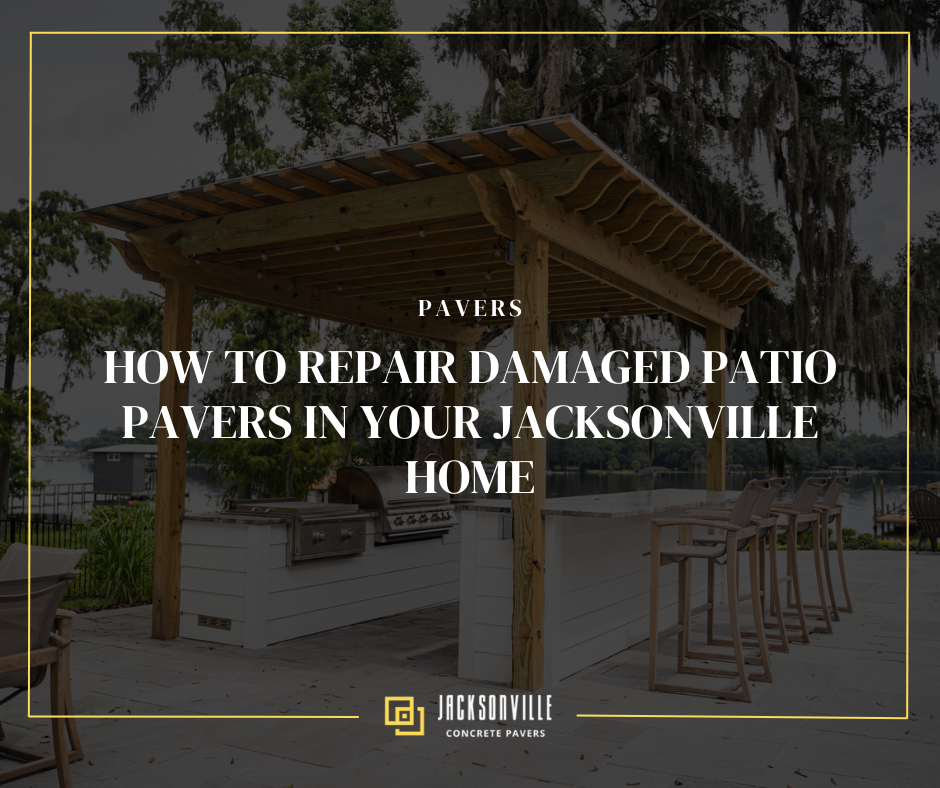How to Repair Damaged Patio Pavers in Your Jacksonville Home
Paver Repair in Jacksonville Florida

A patio is an outdoor extension of your home where you can unwind, entertain, and spend time with family and friends. If you have a patio, you know how relaxing it is to sit outside and breathe in some fresh air. But you also understand how critical keeping it in good condition is.
Constant exposure to the elements, harsh weather conditions, wear and tear, and other factors can damage pavers over time, resulting in uneven surfaces, cracks, and discoloration. If left unchecked, this damage will worsen, making your patio dangerous to walk on and reducing its aesthetic appeal. Repairing them may appear difficult, but it is essential for maintaining the appearance and functionality of your patio.
We'll walk you through the process of repairing damaged patio pavers in your home in this article. We'll go over the tools you'll need, the steps to take, and some pointers to help you avoid future problems.
Tools Required for Patio Paver Repair
Before you begin repairing your damaged paver patio, gather the necessary tools you will require:
- Screwdriver or chisel
- Saw or a chisel
- Trowel
- Hand tamper or broom plate compactor
- Sealant
Repairing a Damaged Paver Patio: A Step-by-Step Guide
Determine the Pavers That Have Been Damaged
Before you can repair the damaged patio pavers, you must first determine which ones are damaged and assess the extent of the damage. Walk around the patio, looking for cracks, chips, or holes in the pavers, and mark the broken, chipped, or discoloured pavers with chalk or tape to make it easier to find them later.
Make a mental note of their size and location. Don't forget to count how many pavers need to be replaced.
Take out the damaged pavers
You must remove the damaged pavers from the concrete pavers patio once you have identified them. Put on your safety glasses and gloves, and use a chisel or a screwdriver to gently remove the broken pieces. Take care not to damage the surrounding pavers or the foundation. You may also need to remove the sand or gravel that has accumulated around the pavers.
If the pavers are stuck in place, cut them out with a saw or chisel.
Clean the Surface
You must now prepare the ground for the new pavers. Make sure the area is clean and debris-free. Remove any dirt or sand with a stiff-bristled brush. Then, add a layer of sand or gravel in the area where the damaged pavers were removed. Level the surface with a trowel and remove any debris from the area.
Measure & cut the new pavers to size
You must cut the new pavers to the proper size before installing them with a saw or chisel. Check that the new pavers fit snugly in the space where the old ones were removed.
Replace the Pavers
Once the new pavers have been cut to accurate dimensions, it is time to install them in the empty spaces where the old pavers were removed. Tap the pavers into place with a rubber mallet OR firmly press them into place with a plate compactor or hand tamper. Allow a small gap between each paver to allow for the addition of sand or gravel later.
Fill in the Blanks & Compact
You must fill the gaps between the new pavers after they have been installed. Sweep sand or gravel into the gaps with a broom. Check that the sand or gravel is level with the pavers' tops.
You must compact the pavers to ensure their security and stability with a plate compactor or a hand tamper. This ensures that they are level and will not shift or move over time.
Use Quality Sealant
After the pavers have been installed and compacted, the final step is to seal them. This will protect the pavers from the elements and allow them to last longer, extending their lifespan.
Choose a high-quality paver sealant and follow the manufacturer's instructions. Apply the sealant evenly and cover all of the pavers.
Patio Pavers Maintenance
It is necessary to maintain your patio pavers on a regular basis to avoid further damage. Sweep away any accumulated debris or leaves. Remove any stains or dirt from your patio by power washing it. Use a weed killer as well to keep weeds from growing between the pavers.
Conclusion
Repairing damaged patio pavers (concrete, clay, natural stone, or brick paver patio) may appear difficult, but it can be done quickly and easily with the right tools and techniques. You can repair your patio and enjoy it for years if you follow these steps. Remember to keep your large concrete pavers for patio in good condition to avoid future damage and to ensure their longevity.
If the damage is extensive or the foundation is unstable, you may need to hire a professional to repair your patio. Design your backyard pavers patio with us!
FAQs
- How frequently should I clean my patio?
You should clean your patio at least once every few months.
- Is it possible for me to repair the damaged pavers myself?
Yes, by following the steps outlined in this article, you can repair the damaged pavers yourself.
- What equipment do I need to repair my patio pavers?
A chisel or screwdriver, saw or chisel, trowel, broom, plate compactor or hand tamper, and sealant are required.
- How can I keep my patio pavers in good condition in the future?
Maintain your patio pavers on a regular basis, use a sealant, and avoid placing heavy objects or vehicles on the surface to prevent damage.
- How long will it take to repair patio pavers that have been damaged?
Repairing damaged patio pavers takes time, depending on the extent of the damage and the size of the area to be repaired. However, it is usually completed in a day or two.




